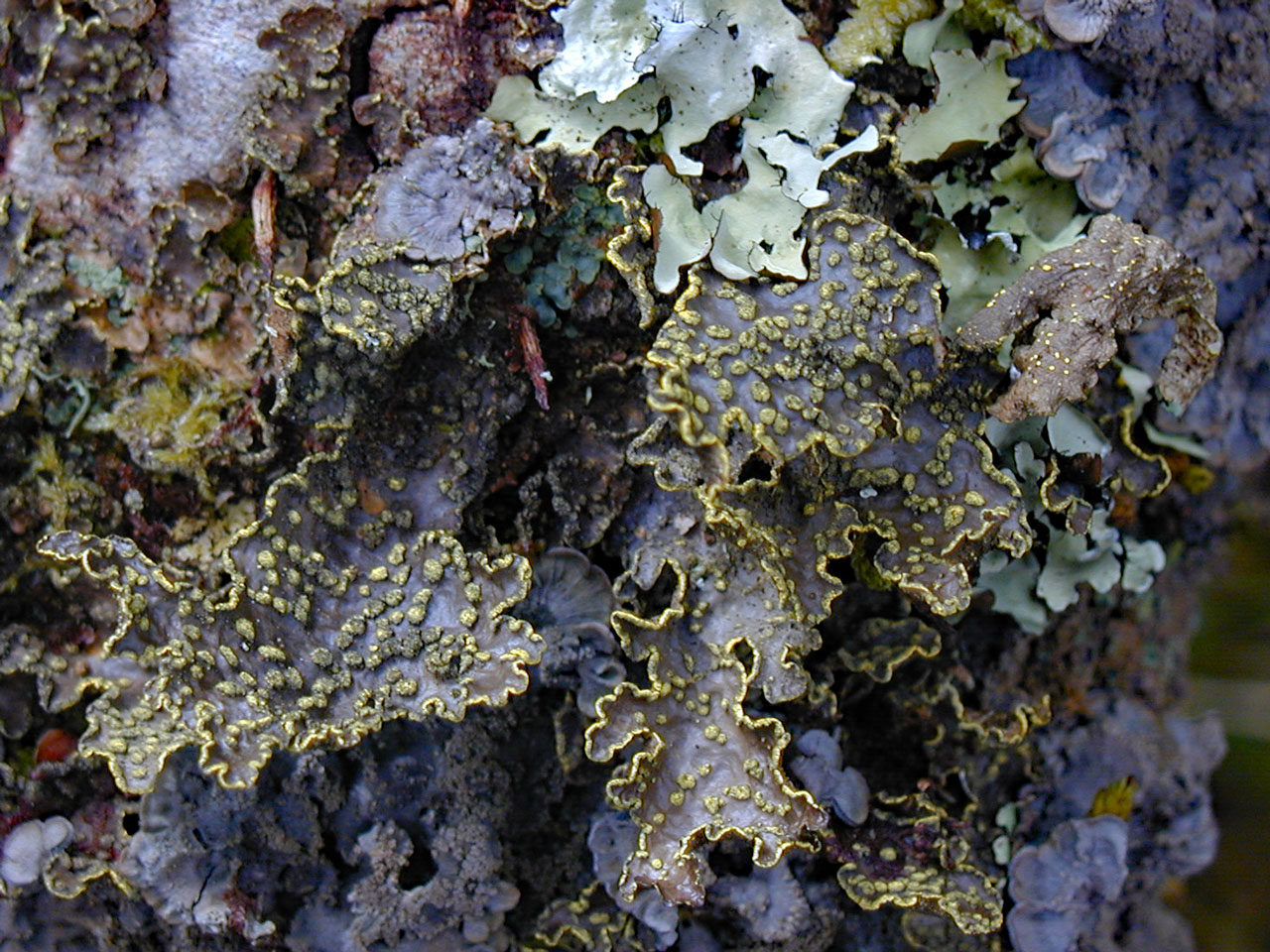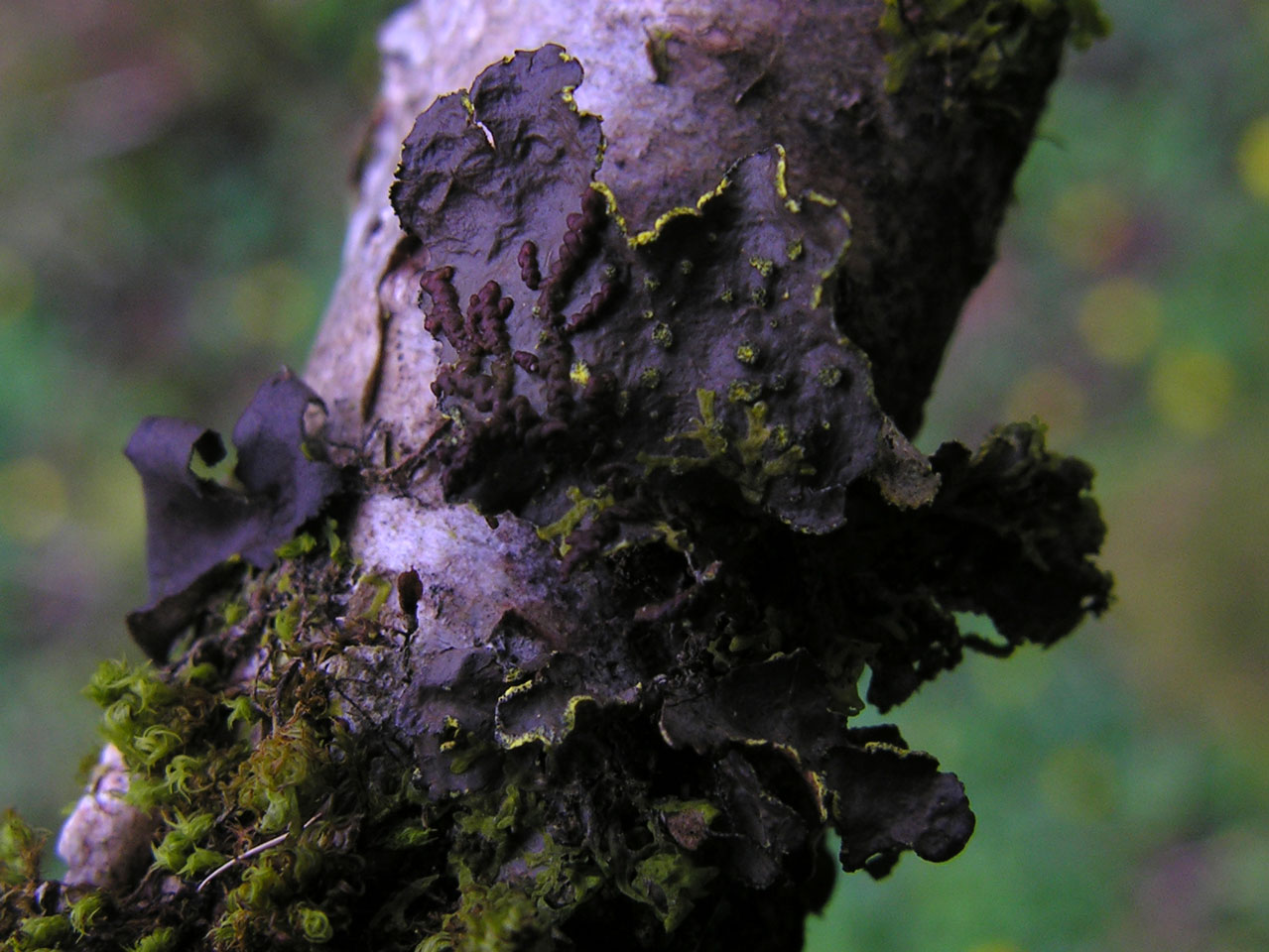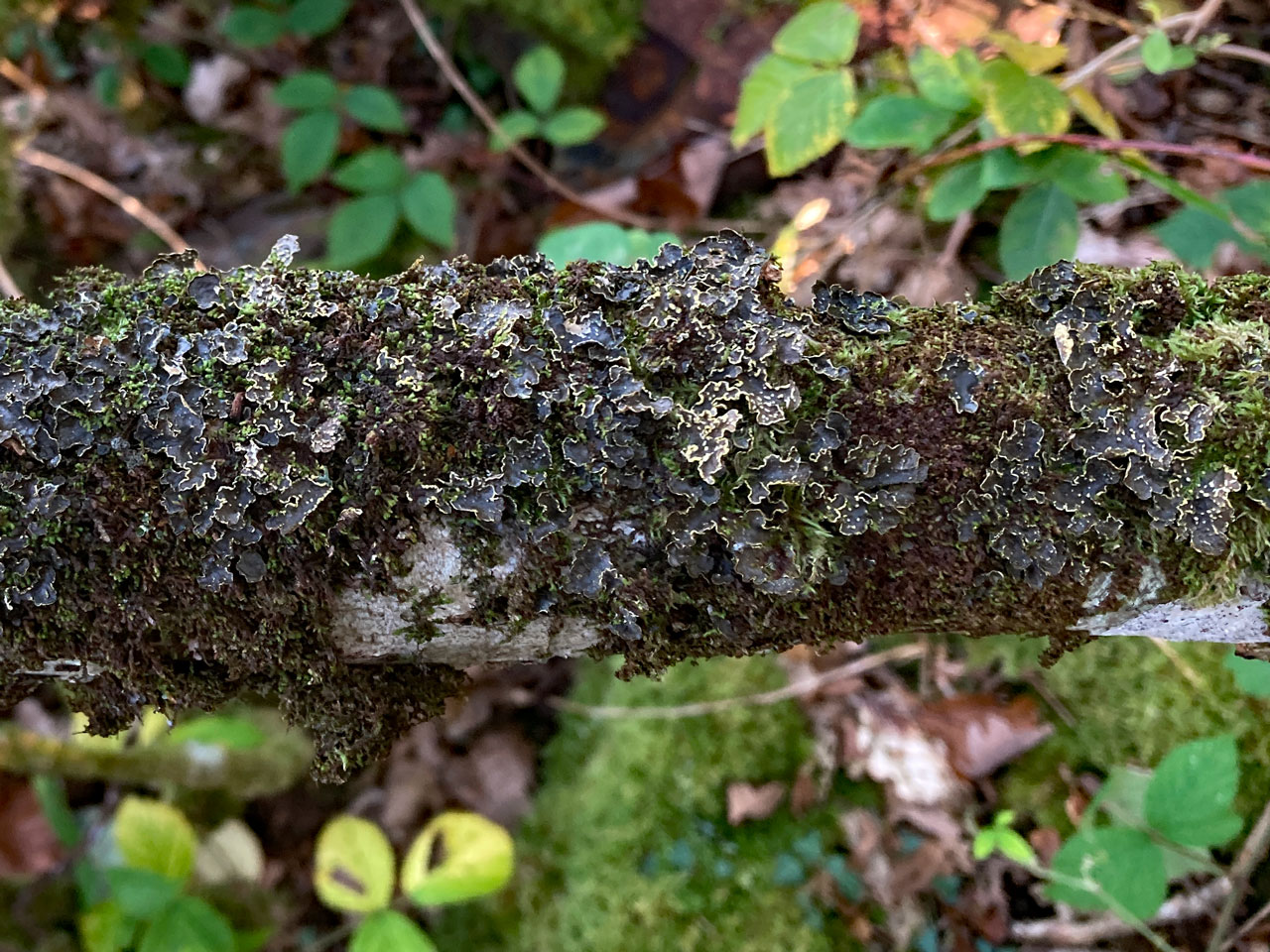A spectacular Speckledbelly, with distinctive yellow punctiform soralia forming within the thallus as well as the thallus edge. Only confusable with the very rare Crocodia aurata (Pseudocyphellaria aurata) but this has a green photobiont as well as the yellow soralia being predominantly marginal. Still a widespread if local feature of the specular Lobarion communities of the west Highland rainforests in old woodlands, extending into more disturbed woods as a relic species on mossy boulders. The population here is of European importance.
Very rare beyond in Ireland, recently mainly recorded in the Hazel woods of The Burren, Co Clare, and thought potentially extinct in England, until refound in 2022. In England it was rediscovered on two trees in the magical coastal dwarfed Atlantic Oak wood of The Dizzard in Cornwall.
Long known under the name Pseudocyphellaria crocata, but this is now known to be an Asian tropical species, and instead our lichen is a pan temperate species, P. citrina, currently also known from North and South America and Macaronesia.
Thallus 2–3 (–10) cm diam., at first rosette-forming, soon irregularly spreading; lobes 5–15 mm broad, rounded or elongate, indented at the apices, often discrete at the margins and overlapping centrally; upper surface pale grey-brown (in shade) to dark red-brown, smooth or with a ± coarse ridged network from which yellow soralia are derived, at first punctiform, later becoming confluent; medulla white; lower surface pale brown, darker brown towards the centre, tomentose to the margins, with frequent conspicuous yellow pseudocyphellae; photobiont blue-green. Apothecia very rare, disc 1–2 mm diam., dark red-brown, margin thin, pale reddish brown, often wrinkled. Ascospores (18–) 22–30 × 5–9 (–12) μm, 1(-3)-septate, fusiform, brown. Medulla and soralia C–, K+ yellow, KC–, Pd+ orange, UV± dull orange (pulvinic, stictic and constictic acids, pulvinic lactone, calycin, tenuiorin, methylgyrophorate and hopane-6α,7β,22-triol, norstictic acid in the apothecia).
Characterised by the blue-green photobiont, white medulla, yellow pseudocyphellae and yellow soralia which are laminal and marginal, and the presence of stictic acid (Pd+ orange). A very distinctive lichen, the most similar species is the very rare Crocodia aurata (Pseudocyphellaria aurata) but this has a green photobiont and a yellow medulla as well as yellow soralia which are also predominantly marginal along with a very different chemistry (Pd–). The yellow soralia separate this lichen from other otherwise similar Pseudocyphellaria species, or Nephroma parile.
Revision of the Pseudocyphellaria crocata group in the Americas (Lücking et al. 2017) revealed that P. crocata s. str. does not occur in the New World. The identity and distribution of genuine P. crocata (type from India) needs further study; only a single sequence of a specimen from Thailand representing this species is currently available, and its voucher could not be located (Lücking et al. 2017). ITS barcodes of multiple samples from Scotland and Macaronesia (Canary Is. and Madeira) show that they also do not belong to P. crocata s. str. as represented by the Thai sequence, and conform instead to P. citrina, a widespread species in the temperate New World.
In rich Lobarion communities on mossy trunks and branches of Hazel, Ash, Oak, Rowan, Sallow and old Heather stems and mossy rock outcrops in moist or boggy sheltered well-wooded or coastal sites. In Scotland as an epiphyte mainly found in old growth pasture woodlands, but survives on mossy rocks in more disturbed woodlands such as 19th century Oak plantations.

Still widespread but local in temperate rainforests in western Scotland, however, now very rare beyond in Ireland and England. In Ireland there are recent records only from The Burren, where is still scattered through the older Hazel woods, and south west Galway. Not recorded recently from the temperate rainforests in west Cork and Kerry, but it should be looked for there.
In England now very rare and it was feared extinct until 2022. The last known sites were two woods in the Barle Valley in Exmoor in temperate rainforests and in the Dizzard, East Cornwall, in drier coastal dwarfed Oak woodland. In the Exmoor sites the lichen was lost to increased shade after grazing was removed from the two woodlands, with the last sitings in the 1990s. Recent surveys have failed to refind it here and it appears lost (Sanderson, 2017). At The Dizzard, a sizeable colony appears to have existed in the 1980s but the exact location of this was lost in this very difficult to access woodland. A recent intensive survey, however, refound it, with a large colony on one Oak and as a recent colonist on a Sallow. The location was near the estimated location of the 1980s records, but even more inaccessible. It is possible the original colony had been lost to a landslip of become over shaded (Lamacraft & Sanderson, 2022).
The species could potential occur in other coastal slope woodlands in the south west but most of these are becoming too shaded as well due to the withdrawal of extensive grazing (Sanderson, 2021).
Probably lost mainly to air pollution and habitat loss south of the Scottish Highlands but declines in traditional management by extensive grazing, and hence increasing shade, have been common factors in recent losses in the English sites. At The Dizzard the arrival of wild red deer in the coastal slope woodland here has stopped the increase in shade and the thickening of the woodland after a longterm decline in grazing pressure. Even in Scotland, a significant current threat is inappropriate reductions in grazing pressure to achieve high levels tree regeneration without fully assessing the impact on the internationally important lichen flora of the temperate rainforests.
Britain: Notable & International Responsibility Species
Scotland: Priority Taxon for Biodiversity in Scotland
England: not assessed, but Critically Endangered on current evidence
Cannon, P., Magain, N., Sérusiaux, E., Yahr, R., Coppins, B., Sanderson, N. & Simkin, J. (2021). Peltigerales: Peltigeraceae, including the genera Crocodia, Lobaria, Lobarina, Nephroma, Peltigera, Pseudocyphellaria, Ricasolia, Solorina and Sticta. Revisions of British and Irish Lichens 20: 1-34
Lamacraft, D. M. & Sanderson, N.A., (2022) Survey of the Dizzard for Pseudocyphellaria citrina. A report to Natural England.
Lücking, R., Moncada, B., McCune, B., Farkas, E., Goffinet, B., Parker, D., Chaves, J.L., Lőkös, L., Nelson, P.R., Spribille, T., Stenroos, S., Wheeler, T., Yanez-Ayabaca, A., Dillman, K., Gockman, O.T., Goward, T., Hollinger, J., Tripp, E.A., Villella, J., Álvaro-Alba, W.R., Arango, C.J., Cáceres, M.E.S., Coca, L.F., Printzen, C., Rodríguez, C., Scharnagl, K., Rozzi, R., Soto-Medina, E. & Yakovchenko, L.S. (2017). Pseudocyphellaria crocata (Ascomycota: Lobariaceae) in the Americas is revealed to be thirteen species, and none of them is P. crocata. Bryologist 120: 441–500.
Sanderson, N. A. (2017) The Status of Parmeliella testacea & Fuscopannaria sampaiana in Devon & Somerset. A Botanical Survey & Assessment report to Plantlife.
Sanderson, N. A. (2021) Porina effilata and Arthonia anglica Clovelly to Peppercombe, North Devon and Arthonia anglica in the New Forest, Hampshire. A report by Botanical Survey & Assessment to Natural England.
Text by Neil A Sanderson based on Cannon et al (2021)






